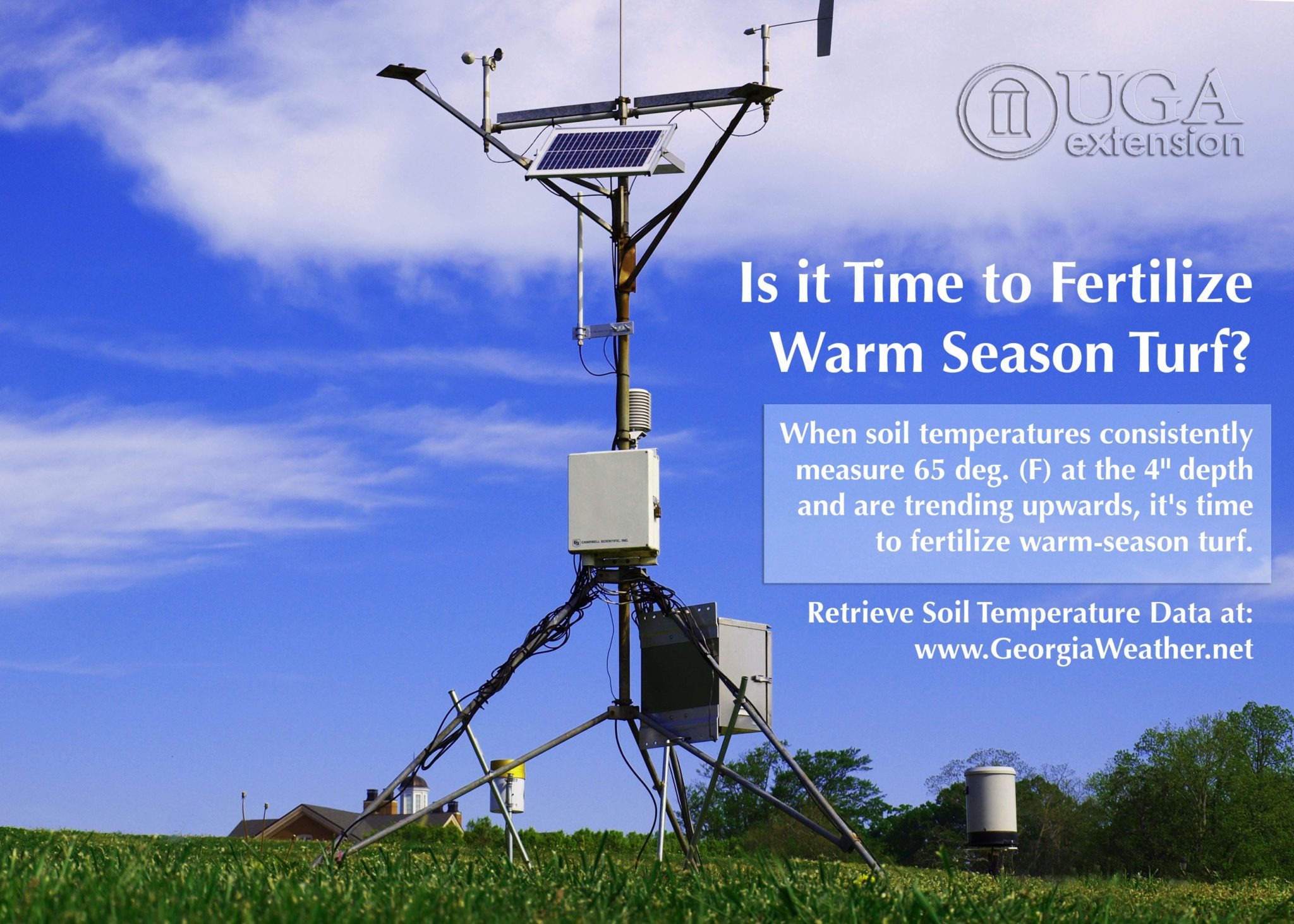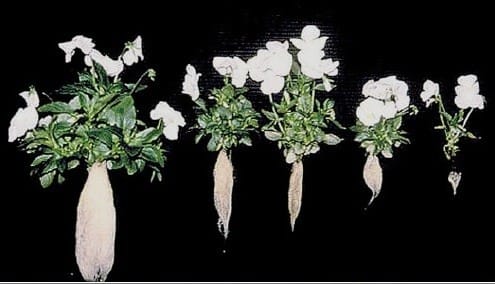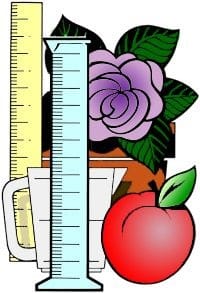“When soil temperatures consistently measure 65 degrees (F) at the 4″ depth and are trending upwards, it’s time to fertilize warm-season turf,” says Dr. Clint Waltz, UGA Turfgrass Extension Specialist. Resisting the temptation to fertilize warm-season turf too early in the season not only conserves valuable time and resources, but encourages a healthy competitive lawn. Spring season air temperatures often fluctuate from lows in the mid 40’s to highs in the mid 70’s, resulting in wide swings in soil temperature. The best time to fertilize warm-season turfgrasses such as bermudagrass, zoysiagrass, St. Augustinegrass, and centipedegrass is during the active growth season spanning May through August when air temperatures reach highs in the mid 80’s to 90’s and soil temperatures remain well above 65 degrees.
Fertilization
Getting the most from pansies and violas in the landscape
Info is taken from the Georgia Guide for Production and Landscape Use of Pansy and Violas by Paul A. Thomas and Jean L. Williams-Woodward, Extension Specialists, UGA College of Agricultural and Environmental Sciences.
Here are some tips on care for pansies and violas in the landscape from this publication.
- Maintain a soil pH of 5.4 to 6.2. If your pH rises above 6.2, you will run into nutritional and disease problems. If your pH falls below 5.2, you risk nutrient toxicities.
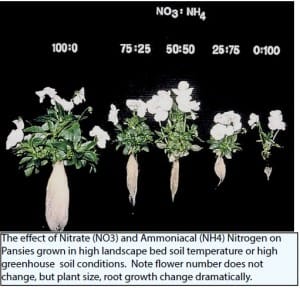 Use fertilizer containing the nitrate (NO3) form of nitrogen (as opposed to ammoniacal nitrogen (NH4) or urea) Nitrate is taken up more readily in cold weather, and it does not cause as much stretching in hot weather. Products such as 15-2-20, and other products especially formulated for pansies have enhanced nitrate over ammoniacal nitrogen ratios, possess low phosphorus, and generally have the fertilizer elements in the right ratios for pansies.
Use fertilizer containing the nitrate (NO3) form of nitrogen (as opposed to ammoniacal nitrogen (NH4) or urea) Nitrate is taken up more readily in cold weather, and it does not cause as much stretching in hot weather. Products such as 15-2-20, and other products especially formulated for pansies have enhanced nitrate over ammoniacal nitrogen ratios, possess low phosphorus, and generally have the fertilizer elements in the right ratios for pansies.
- If you use calcium nitrate [Ca(NO3)2] as a nitrogen source without added boron, you run the risk of saturating the plant with calcium. This abundance of calcium can cause a boron deficiency since calcium blocks boron uptake by the roots. Frequent irrigation and use of less-expensive fertilizers without balanced trace elements can also cause serious boron imbalances. A boron deficiency appears as tightly bunched up new growth that eventually leads to deformed leaves and poor flowering. If you need to supplement Boron, use a drench by mixing 0.85g borax (11%B) or 0.48g Solubor(20%B) per 100 gallons of water.
-
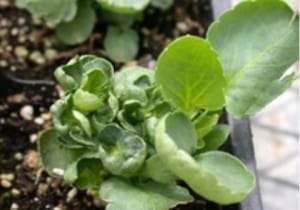
Boron deficiency in pansies Carefully monitor irrigation and keep pansies slightly on the “dry side of moist soil” to “harden” growth prior to very cold weather. If your beds are continuously wet, even in periods of normal rainfall, consider adding organic matter and other materials next year to increase drainage for the next pansy season.
- Pine straw, applied 2 to 4 inches thick, over the top of the entire bed (plants and all) during extreme cold is one of the best ways to save a pansy planting from freeze injury. This helps trap heat in the soil, prevents it from freezing and greatly reduces plant exposure to cold and desiccating wind. Carefully rake the pine straw off the bed when the cold weather passes.
- These freeze protection measures are generally taken only when the air temperature is expected to drop below 20 degrees F for a considerable length of time, and when dry, cold winds accompany the weather change, and especially when the soil is in jeopardy of freezing solid. Healthy plants can generally survive short periods of temperatures down to the single digits without protection.
The publication also includes information on diseases, in-depth soil and plant fertility info and other good sources of information. See the entire publication.
Pansies, Violas, and More! Getting the Most Out of Winter Color Beds
Bodie Pennisi, Department of Horticulture, UGA
Cool weather is upon us and with it, pansy season! Even though pansies are the mainstay for winter color beds, there are increasingly more plant choices available, providing an exciting palette for landscapers to play with.
The following veggies are used for height, color, texture and vegetative element:
- Ornamental Cabbage
- Kale
- Swiss Chard
- Mustards
- Lettuces
- Parsley
- Cardoon (Ornamental Artichoke)
- Oregano
- Thyme
Other flowering winter annuals are:
- Alyssum
- Iberis
- Dusty Miller
- Cool season grasses
Perennial plants that serve as foliage accents are:
- Sedums
- Ivy
- Evergreens
- Acorus
- Heuchera
- Dusty Miller
- Carex
- Euphorbia – these can be year-round
Deer-resistant plants used as flowering accents are:
- Dianthus
- Snapdragons
- Poppies
- Scabiosa
The pansies and their cousins, the violas, are the bread and butter of the winter color beds, so let’s take a look at how we can keep them happy and flowering all winter long! First, a few words about each of these:

Pansies
- Larger, fewer blooms per plant
- Need minimum of 6 hours of direct sunlight
- Need dead-heading
- Slower to recover after a hard freeze
Violas
- Small, multiple blooms per plant
- Can tolerate some shade
- Self-cleaning
- Higher nutrition for better performance
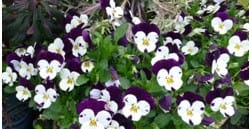
Planting season starts in October, which usually gives the plants ample time to grow and develop a good root system in favorable temperatures before the winter settles in. This starts with the right foundation – the bed.
If you have existing beds, make sure you remove all plant debris from the summer planting, including any mulch. Get a soil test, which will tell you important information about the existing nutrient levels and the soil pH. Remember that pH controls nutrient availability – too high, and the plants develop deficiencies, too low, and the plants develop toxicities.
Ideal soil pH for pansies should be between 5.4 and 5.8. pH higher than 5.8 can lead to increased incidence of black root rot, a devastating disease on pansies and violas. You should test the soil later in the growing season as well, because pH does change.
Make sure you add organic matter to the bed and till well, 8-12 inches deep. Rake to create a gentle slope and trench the front edge of the bed to help with drainage. If you are making new beds, use the following soil recipe: 60% well-aged compost, 20% gravel (#89), 10% coarse sand, and less than 10% native soil.
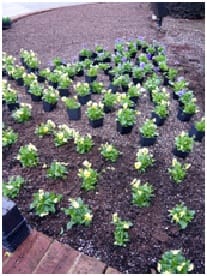
To get a better idea of how the planting will appear – pre-set large beds. The recommended spacing for fall planting is 8” on center and 10” on center for spring planting.
Gently remove the plant from the pot by inverting the pot and squeezing the sides to release the root ball. Before you plant, examine the root system. A healthy root system has many fine white roots and is not pot-bound. Brown-colored, water-soaked roots are an indication of disease – you should not plant affected plants.
Make sure you plant at the same level the plants originally grew, not deeper, nor shallower.
Mulch is essential for many reasons – weed control, keeping soil temperatures higher, and preventing soil desiccation. Small-size pine nuggets work very well.
After a thorough watering you should liquid-feed the plants for faster establishment. In addition, top-dress the beds with a slow-release fertilizer to ensure an adequate level of fertility.
Low temperatures will become an issue as winter settles in. Even though the soil in Georgia very rarely freezes (exception in the Mountains), soil temperatures below 45oF causes slow growth due to low uptake of nutrients. Plants stop flowering and appear starving even if high fertility is present in the soil!
When soil temperatures drop below 60 oF, begin a liquid feed program with a formula having at least 50% nitrate nitrogen, such as calcium nitrate, potassium nitrate, or magnesium nitrate. The reason being is that ammonia-based fertilizers are not utilized because the bacteria responsible for converting them to a form that the plant roots can absorb are not as active in temperatures below 60 oF. Applying ammonia fertilizer is not only a waste of money but it can also compromise the health of your pansies and violas.
For best results, apply a standard 15-2-20 formula, high-nitrate pansy formula fertilizer at 4-day intervals through March 15. These formulations also have little effect on soil pH, so nutrient deficiencies are less likely to occur. Fertilization frequency depends on the vigor and performance of the planting – more frequent feeding may be needed when the growth is good. If a period of warm weather occurs, cut back on the liquid feed to avoid foliar stretching during the midwinter, which may result in weak, floppy stems. When fertilizing with liquids, apply enough liquid to saturate soil to a depth of 4- to 6-inches.
Removing frost-damaged flowers and old, faded flowers should be a top priority with pansies; not only for aesthetics but to prevent the onset of seed pods that consume the plant’s energy. This also reduces the changes of fungal blight diseases that feed on old blossoms. Trim lanky shoots periodically to encourage branching, compact growth and improved flowering.
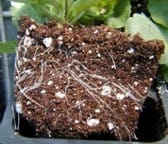
Emphasizing again the soil pH, make sure you test during the season. If the soil pH rises above 5.8, drench at 10-day intervals with either iron sulfate or aluminum sulfate (1 to 3 lbs/ 100 gal) to lower the pH. Lightly rinse plants after application to prevent foliage injury. Continue these corrective treatments until the soil pH drops and stays in the 5.4 to 5.8 range.
Soil temperatures usually are on the rise by March 15, so you can start using fertilizers containing ammonia nitrogen. Use the standard fertility program for summer annuals – 200 ppm 20-20-20 (N-P-K) or a slow release/granular fertilizer during the remainder of the growing season.
For more information:
Conversion Tables, Formulas and Suggested Guidelines for Horticultural Use
Bodie V. Pennisi, Gary L. Wade, Melvin P. Garber, Paul A. Thomas and James T. Midcap, Horticulture Department Originally prepared by S.C. Myers and A.J. Lewis, Extension Horticulturists

- Equivalents for liquid measure (volume)
- Metric system conversion table
- Dilution of liquid pesticides at various concentrations
- Equivalent quantities of dry materials (wettable powders) for various quantities of water based on recommended pounds per 100 gallons
- Equivalent quantities of liquid materials (emulsion concentrates, etc.) for various quantities of water based on pints per 100 gallons
- Rate of application equivalent table
- Fertilizer conversions for specified square feet and row areas
- Fertilizer weight as measured by standard pot size
- Element concentrations for pounds soluble fertilizer in 1000 gallons (U.S.) water
- Number of pots per bushel and per cubic yard of soil mix
- Coverage estimates for perlite, peat, topsoil and straw
- Plant spacing guide (greenhouse)
- Plant spacing guide (field/orchard)
Formulas for calculating greenhouse volume
- Uneven-span greenhouses
- Quonset structures
- Even-span greenhouses
Pesticide and fertilizer recommendations are often made on a pounds per acre and tons per acre basis. While these may be applicable to field production of many crops, orchardists, nurserymen and greenhouse operators often must convert these recommendations to smaller areas, such as row feet, square feet, or even per tree or per pot. Thus pints, cups, ounces, tablespoons and teaspoons are the common units of measure. The conversion is frequently complicated by metric units of measure. This publication is designed to aid growers in making these calculations and conversions, and also provides other data useful in the management, planning and operation of horticultural enterprises.
See the entire publication here
Get the most from your pansies!
By now, most pansies are in the ground. Now it is time for winter care to improve their performance! UGA Extension has an excellent publication on growing pansies – Success with Pansies in the Winter Landscape: A Guide for Landscape Professionals. It provides info and the practices that help us get the most from our pansies.
 Here are some examples of info from this publication. Did you know?
Here are some examples of info from this publication. Did you know?
- Once the weather cools and soil temperatures drop below 60° F, pansies grow better when fed a liquid feed program using a fertilizer containing at least 50 percent of its nitrogen in the nitrate form.
- Fertilizers containing more ammonia can be used more once soils warm in the spring – starting about March 15.
- Reduce fertilization during warm weather to control plant growth.
- Pansies grow best in soils with a pH of 5.4 – 5.8. Higher pH encourages boron and iron deficiencies while making plants more susceptible to black root rot.
- Removing frost-damaged and old and faded flowers improves the looks of the bed, encourages more flowering and can reduce disease incidence.
- You can trim lanky branches to produce stocky plants with more branches and flowers.
Several insects and diseases affect pansies. For help identifying these problems, contact your local Extension Office.
For more information, see the entire publication here.
